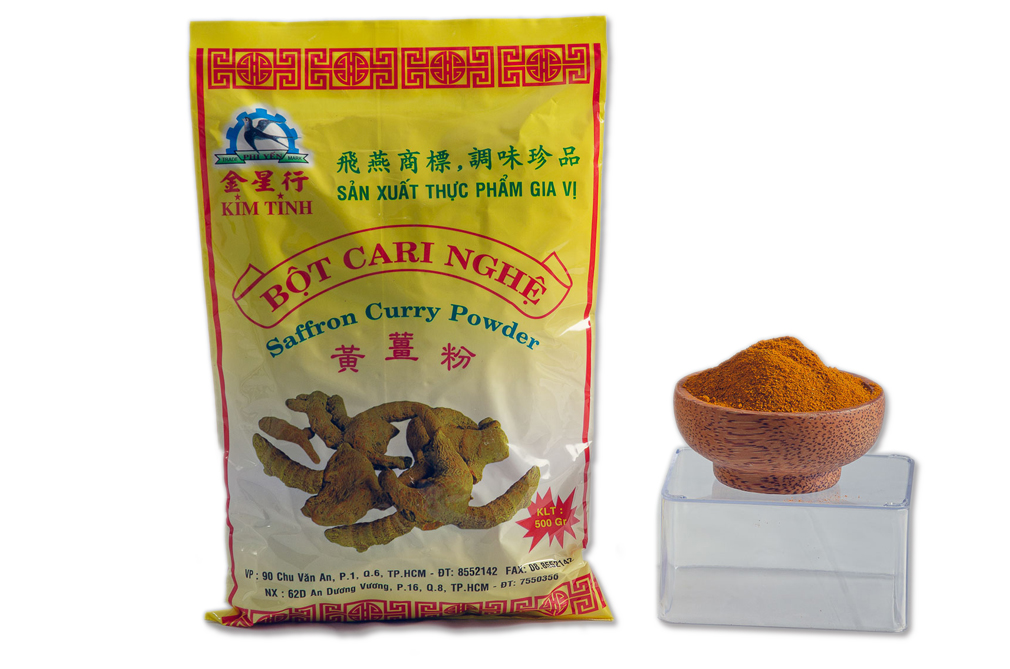Turmeric powder
30/08/2020
Product Type: Chili Powder and Turmeric Powder
Customer support
Hotline: 028 3755 0356
(From Monday to Sunday)
Ingredients: Turmeric 100%
Usage: Turmeric powder is used to spice up fried meat, stir-fry, cook such as: Sheep, Goat, Beef, Pork, Chicken, Fish, Crab, Shrimp and curry, cook peanut vermicelli, pour pancakes
Preservation: Store in a cool, dry place, avoid direct sunlight on the product. Leftover products after using should be stored in sealed jars. Should use spices before the date expires. Do not use if the bag has been opened or torn.
Expiry date: 2 years
Origin:
Turmeric or home turmeric, cultivated turmeric, Khuong Hoang (two part nomenclature: Curcuma longa) is a perennial herbaceous plant belonging to the Ginger family (Zingiberaceae), with underground tubers (rhizomes). It is native to tropical Tamil Nadu, southeastern India, and requires temperatures between 20 degrees C and 30 degrees C (68 degrees F and 86 degrees F) and substantial annual rainfall to thrive. . Trees are harvested annually for the tubers, and propagated from a portion of them the following season. Turmeric also known as haldi, turmeric has been used in South India for thousands of years and is a major ingredient in Siddha medicine. It was first used as a dye and then later for its medicinal properties. (Turmeric)
Characteristic:
When not used immediately, the tubers are boiled for 30 to 45 minutes and then dried in a hot oven. They are then ground into a dark orange-yellow powder that is often used as a seasoning in Tamil cuisine and even curries, or to color and color the mustard spices. Its active ingredient is curcumin with a slightly hot, slightly bitter taste, has a mustard scent, and ‘carries the taste of earth 'differently. Curcumin is a hot spot for its potential therapeutic properties with a number of ailments, including cancer, Alzheimer's, diabetes, allergies, arthritis, and other chronic ailments. India is a major producer of turmeric, with regional names depending on language and country.
Turmeric grows wild in the forests of South Asia and Southeast Asia. It is one of the main ingredients in many Asian dishes. Traditional Tamil medicine, also known as Siddha, has suggested using turmeric in food for its potential therapeutic value, which is still a topic of research. Its use as a colorant has no major value in South Asian cuisine.
Uses:
Turmeric is mainly used in savory dishes, but is also used in some sweet dishes like the cake Sfouf. In India, turmeric leaves are used to make a sweet dish, especially patoleo, by placing rice flour with a mixture of coconut and jaggery on the leaves, then wrapping and steaming in a special copper steamer. (Goa).
In recipes outside South Asia, turmeric is sometimes used as a bright yellow agent. It is used in canned beverages and baked products, dairy products, ice cream, yogurt, yellow pastries, orange juice, biscuits, popcorn color, candy, cake, cereals, water sauce, gelatin ... This is an important ingredient in most commercial curry powders.
Most turmeric is used in the form of root powder, in some regions (especially in Maharashtra, Goa, Konkan and Kanara), turmeric leaves are used to wrap and cook food. This usage of turmeric leaves is usually where turmeric is grown, as the leaves are used as soon as they are harvested. Turmeric leaves give off a special flavor.
Although commonly used in dry powder form, turmeric is also used fresh, such as ginger. It has many uses in Far Eastern recipes, such as pickles made from fresh turmeric containing soft turmeric chunks.
Turmeric is widely used as a spice in South Asian and Middle Eastern cuisines. Many Persian dishes use turmeric as a starter ingredient. Almost all fried foods in Iran have oil, onions, and turmeric along with any other ingredients that will be added.
In Nepal, turmeric is grown and is widely used in many vegetables and meat dishes for its color and potential value in traditional medicine. In South Africa, turmeric is used to give rice a golden color.
In Vietnam, turmeric powder is used to color, and enhance the flavor of, certain dishes, such as banh xeo, banh khot and quang noodle. Turmeric powder is also used in many stir-fries and soups in Vietnam.
In Indonesia, turmeric leaves are used for Minangese or Padangese curry in Sumatra, such as rendang, sate padang and many others.
In Thailand, fresh turmeric is widely used in many dishes, especially in southern Thai dishes, such as yellow curry (แกง เหลือง) and turmeric soup (ต้ม ขมิ้น).
During medieval Europe, turmeric was known as Indian saffron because it was widely used as a substitute for saffron, a much more expensive spice.


